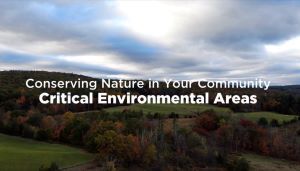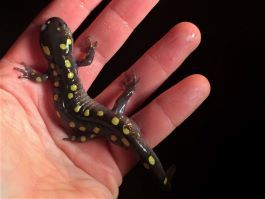New Video: Critical Environmental Areas
Now more than ever, communities recognize the value of having access to nature for recreation and rejuvenation. But long before this season of social distancing, municipalities in the Hudson estuary watershed pursued plans and policies to conserve natural areas for many additional reasons, including biodiversity, clean water, and climate adaptation.
 DEC’s Hudson River Estuary Program has just released a new video, Conserving Nature in Your Community: Critical Environmental Areas, to showcase the Town of Wawarsing’s leadership as a model in local conservation planning. Following a multi-year process to inventory and prioritize its natural areas, the Ulster County town took important steps to conserve its ecological assets and quality-of-life for residents. First, the town utilized critical environmental area (CEA) designation to help protect the exceptional and unique character of a large wetland complex and an important landscape connection between the Catskills and Shawangunk Ridge. Soon after, the town adopted the NYS Climate Smart Communities (CSC) pledge to formalize its continuing commitment to being a resilient community. This process is captured in the video through interviews with local officials and footage of the beautiful town. DEC’s Hudson River Estuary Program has just released a new video, Conserving Nature in Your Community: Critical Environmental Areas, to showcase the Town of Wawarsing’s leadership as a model in local conservation planning. Following a multi-year process to inventory and prioritize its natural areas, the Ulster County town took important steps to conserve its ecological assets and quality-of-life for residents. First, the town utilized critical environmental area (CEA) designation to help protect the exceptional and unique character of a large wetland complex and an important landscape connection between the Catskills and Shawangunk Ridge. Soon after, the town adopted the NYS Climate Smart Communities (CSC) pledge to formalize its continuing commitment to being a resilient community. This process is captured in the video through interviews with local officials and footage of the beautiful town.
The town of Wawarsing received technical assistance and grant funding from the Estuary Program to complete its open space inventory, open space plan, and implementation actions. The Climate Smart Communities (CSC) Adaptation Inspiration video series on DEC's YouTube channel introduces actions in the CSC certification program through the work of inspirational communities and partners in the estuary watershed.

Forest Condition Index Webinar May 20, 12 - 1 p.m.
 Conserving forests in the estuary watershed is vital for the multiple benefits they provide communities - but which forests are most important, and why? The Hudson Valley Forest Index is a new data set that maps and prioritizes forest patches based on metrics relating to size, fragmentation, connectivity, stressors, habitat value, and carbon sequestration. This webinar will introduce the new forest condition index and associated core forest data and discuss ways it can be used in conservation and land-use planning. The webinar takes place from 12 – 1 p.m. on Wednesday, May 20. Registration is required. Tim Howard and Amy Conley at the New York Natural Heritage Program, and Nate Nardi-Cyrus, conservation and land use specialist at the Hudson River Estuary Program will present the webinar. Conserving forests in the estuary watershed is vital for the multiple benefits they provide communities - but which forests are most important, and why? The Hudson Valley Forest Index is a new data set that maps and prioritizes forest patches based on metrics relating to size, fragmentation, connectivity, stressors, habitat value, and carbon sequestration. This webinar will introduce the new forest condition index and associated core forest data and discuss ways it can be used in conservation and land-use planning. The webinar takes place from 12 – 1 p.m. on Wednesday, May 20. Registration is required. Tim Howard and Amy Conley at the New York Natural Heritage Program, and Nate Nardi-Cyrus, conservation and land use specialist at the Hudson River Estuary Program will present the webinar.
Amphibians and Vernal Pools Webinar May 21, 1 - 2 p.m.
 Estuary Program staff will be teaming up with our partners at Hudson Highlands Land Trust (HHLT) to talk about forest amphibians and their habitats in a webinar on May 21 at 1 p.m. The webinar is part of the land trust's efforts to bring nature to residents who are staying home due to COVID-19. Laura Heady, conservation and land use program coordinator at the Estuary Program will join Nicole Wooten, natural resources manager at HHLT to discuss the importance of woodland pools and the annual migration of forest amphibians. The webinar is free, but advance registration is required. Visit HHLT's website to learn more about the Bringing Nature to You series and how to register for the May 21 webinar. Estuary Program staff will be teaming up with our partners at Hudson Highlands Land Trust (HHLT) to talk about forest amphibians and their habitats in a webinar on May 21 at 1 p.m. The webinar is part of the land trust's efforts to bring nature to residents who are staying home due to COVID-19. Laura Heady, conservation and land use program coordinator at the Estuary Program will join Nicole Wooten, natural resources manager at HHLT to discuss the importance of woodland pools and the annual migration of forest amphibians. The webinar is free, but advance registration is required. Visit HHLT's website to learn more about the Bringing Nature to You series and how to register for the May 21 webinar.
|


 DEC’s Hudson River Estuary Program has just released a new video,
DEC’s Hudson River Estuary Program has just released a new video, 
 Conserving forests in the estuary watershed is vital for the multiple benefits they provide communities - but which forests are most important, and why? The Hudson Valley Forest Index is a new data set that maps and prioritizes forest patches based on metrics relating to size, fragmentation, connectivity, stressors, habitat value, and carbon sequestration. This webinar will introduce the new forest condition index and associated core forest data and discuss ways it can be used in conservation and land-use planning. The webinar takes place from 12 – 1 p.m. on Wednesday, May 20.
Conserving forests in the estuary watershed is vital for the multiple benefits they provide communities - but which forests are most important, and why? The Hudson Valley Forest Index is a new data set that maps and prioritizes forest patches based on metrics relating to size, fragmentation, connectivity, stressors, habitat value, and carbon sequestration. This webinar will introduce the new forest condition index and associated core forest data and discuss ways it can be used in conservation and land-use planning. The webinar takes place from 12 – 1 p.m. on Wednesday, May 20.  Estuary Program staff will be teaming up with our partners at
Estuary Program staff will be teaming up with our partners at